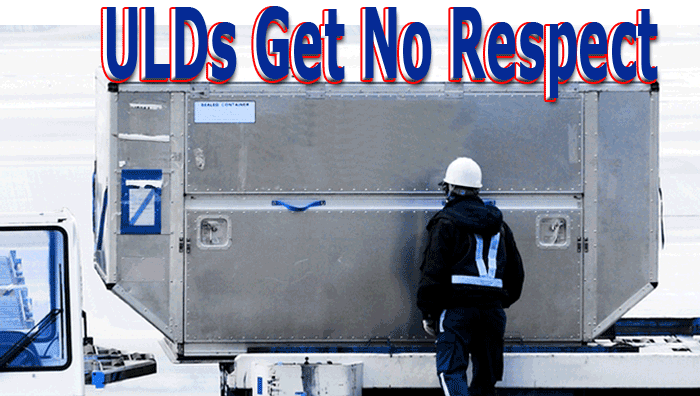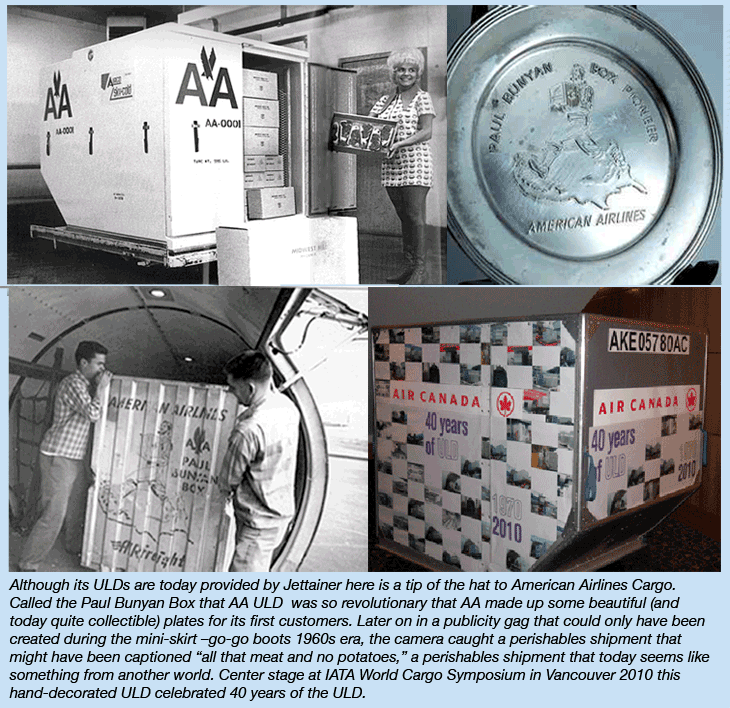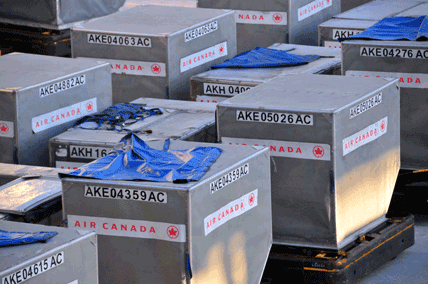
A common
saying goes, “you can’t see the forest for the trees.”
This also seems to be true for the ULD
(or Unit Load Device).
Most everyone in the air cargo business
can identify the common types of ULDs and has seen them in all-day use
for the purpose of carrying cargo, mail, and baggage.
Few people, however, are familiar with
the latest developments around ULDs, the requirements applicable to
their use, and the regulatory background edicts for their usage.
 Thinking
about ULDs and their common perception in our business, we are reminded
of the great American comedian Rodney Dangerfield who used to tell his
audience about his woes and travails:
Thinking
about ULDs and their common perception in our business, we are reminded
of the great American comedian Rodney Dangerfield who used to tell his
audience about his woes and travails:
“You see, I get no respect,”
Rodney would say, and that phrase usually brought down the house.
Legally speaking, ULDs are part of the
aircraft’s equipment and thus subject to stringent airworthiness
requirements.
In other words: A surplus of missing
rivets, damaged doors or locks, bent edges, broken base plates as well
as improper repairs, the wrong tiedown equipment, and overload or unevenly
distributed load will cause the ULD to be used out of its specifications
and thus not be in compliance with applicable FAA, EASA, and IATA rules.
Aircraft manufacturers including Airbus
and Boeing as well as ULD manufacturers have developed stringent guidelines
which, apart from airline-internal guidance such as the COM (Cargo Operations
Manual) or the ASM (Airport Services Manual) can most easily be viewed
in the IATA AHM (Airport Handling Manual) in its current 35th Edition
and the IATA ULD Regulations in its current 3rd edition (the IATA ULD
regulations have replaced the IATA UTM, the ULD Technical Manual, about
three years ago, when the manual was revamped and substantially updated).
 |
Word Up To Forwarders & Shippers
While airlines and ground handlers have paid
increasing attention to the ULD, especially in the past decade for various
reasons—repair costs getting out of hand, empty ULD’s being
too heavy (and thus a surplus of dead load-in times or rising fuel costs)
and damage to aircraft caused by broken and/or improperly loaded ULDs—
the ULD, it can be said, has failed elsewhere to become a focus of freight
forwarders and shippers in the same manner as ULDs have with the airlines.
While the ‘legacy’ way of
doing air cargo business meant that the shipper handed over the cargo
to the forwarder, who in turn tendered it to the airline’s local
handling partner, who in turn built up the cargo via ULDs according
to specifications and instruction supplied by the airline in question,
times have changed:
Forwarders are increasingly looking to
carve off a bigger slice of the revenue cake for themselves, and even
some shippers feel that their own staff can load especially sensitive
loads (such as pharmaceuticals) in a more accurate or compliant manner
than by airline or GHA staff.
Get Your
BUP UP
Almost 20 years ago, the industry developed
the BUP program—BUP standing for Bulk Unitization Program, also
called “CPLU” (Complete Unit) at times.
 Essentially, the airline agrees that either
the shipper or a forwarder tenders a loaded ULD for carriage instead
of loose cargo. Because the airline saves on GHA Buildup charges, a
part of such saving is passed on to the forwarder or shipper, (e.g.
the cargo rate is lowered).
Essentially, the airline agrees that either
the shipper or a forwarder tenders a loaded ULD for carriage instead
of loose cargo. Because the airline saves on GHA Buildup charges, a
part of such saving is passed on to the forwarder or shipper, (e.g.
the cargo rate is lowered).
The deal is mostly sweetened by pivotal
weight agreements, such as a minimum payment for a given ULD (say, a
LD3 AKE Container) equaling a certain weight charge such as 750kg.
Anything loaded in excess of the pivotal
weight by the forwarder or shipper is subject to a further reduced rate,
which may generate considerable revenues to the shipper where the cargo
is question is sufficiently “dense.”
Other types of BUP’s involve special
cargoes such as “GOH,” Garment on Hangers, which allows
for the transport of fashion and apparel from production until delivery
without packaging and the need for ironing before placing the garment
in the store. That ship to sale feature alone accounts for sufficient
savings.
So even though BUP sounds like a win-win
situation – some airlines have experienced otherwise.
Since with most shippers and forwarders
smaller ULDs (such as LD3 AKEs and LD8 ALFs) are in demand and BUP usually
must be transported to the final consignee’s location, airlines
have had to face an imparity of ULD use.
In particular from Asia to the U.S. and
Europe inbound where AKE-type containers are used, an imbalance on return
legs into Asia is noticeable as mostly 10-foot pallets of the PMC or
PAG types are required, causing shortages of ULDs at Asian locations.
So while storage charges are added in
the U.S. and Europe and trucking charges are incurred since only four
to five of the AKE-type LD3 containers fit on one 18-meter standard
trailer, the return of ULDs from smaller airports or the forwarding
of ULDs to other offline airports within the airline’s network
continues to be a costly endeavor.
Security,
Handling & Other Concerns
Since anyone involved in handling identifiable
air cargo is subject to local and international security and safety
requirements, locations of ULD buildup must be ‘secure’
in the context of air security requirements.
Moreover staff involved in buildup activities
are subjected to a background check as well as to repeated training
in accordance with subsection 1.5 of the IATA Dangerous Goods Regulations
(even where no Dangerous Goods are loaded).
Staff Category 5 general awareness training
is the minimum requirement and subsection 1.6 of the IATA ULD Regulations
instruct staff about restrictions and conditions pertinent to the use
of ULDs.
In addition, handling ULDs by means of
forklift is strictly prohibited unless the ULDs are equipped for such
purpose, which very few are.
Also, loading of any dangerous goods in
BUP ULDs is generally prohibited with the exception of some low-risk
DG, subject to individual carrier approval.
In reality, however, the security of such
buildup locations is often questionable at best and training provided
to buildup staff in the context of the IATA Dangerous Goods Regulations
and the IATA ULD Regulations is either non-existent or perfunctory,
meaning one foreman on location holds a more or less recognizable training
certificate meant to cover the entire operation.
Lufthansa
Leadership
While some airlines such as Lufthansa Cargo
have been proactive in advancing ULD technologies and practices for
some time (also as a means to generate revenue from their own ULD buildup
type training), others have so far approved requests from 3rd parties
for BUP carriage without asking too many inconvenient questions.
With increasing pressure from regulators
and interest bodies such as IATA, and with airworthiness rules vigorously
enforced by rampside inspections, the situation is changing—and
it’s changing fast.
Now ULDs damaged by improper handling,
loading, and use are more likely to be taken out of service and subjected
to costly repair by approved repair stations.
In the meantime, airlines exceedingly
look into the credentials of the buildup contractor before approving
BUP-type traffic.
The Unknown
Entity
 When it comes to ULDs there a few outstanding
people—like Bob Rogers from Nordisk (right) (known for both his
drastic and knowledgeable presentations delivered at industry meetings
such as the IATA WCS and the TIACA ACF)—who have dedicated their
professional lives to raising awareness about the ‘unknown entity
ULD’ and have played a pivotal role in spreading the word. Urs
When it comes to ULDs there a few outstanding
people—like Bob Rogers from Nordisk (right) (known for both his
drastic and knowledgeable presentations delivered at industry meetings
such as the IATA WCS and the TIACA ACF)—who have dedicated their
professional lives to raising awareness about the ‘unknown entity
ULD’ and have played a pivotal role in spreading the word. Urs
 Wiesendanger
(left) from Air Canada who also serves as president of the organization
ULD Care
is another stand-up stalwart for better understanding of best practices
in ULDs.
Wiesendanger
(left) from Air Canada who also serves as president of the organization
ULD Care
is another stand-up stalwart for better understanding of best practices
in ULDs.
One inescapable fact is that while in the past
ULD Training requirements were more often than not perfunctorily ‘satisfied’
by subjecting BUP Buildup staff to computer-based training in the English
language (no matter if the attending staff was actually capable of speaking
at least basic English), that practice is now raising red flags in airline’s
cargo departments—and rightfully so.
Looking ahead, freight forwarders will have
to come to a conclusion shippers seem to have made quite a while ago:
Loading ULDs requires qualified and trained
staff, as only dedicated staff aware of the industry requirements will
load a ULD not only in compliance with applicable safety and security
requirements, but also to insure that the load will arrive in the impeccable
state in which it left the production facilities.
The latter, at least for shippers of pharmaceuticals,
is the ultimate goal and the only one that counts.
Jens





